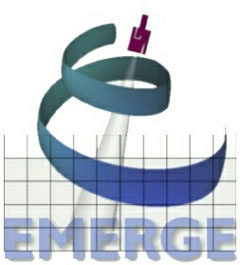Emerge: ESnet / MREN Regional Grid Experimental NGI Testbed
August 1st, 1999 - August 1st, 2001
Categories: Networking

About
This EMERGEeffort means to achieve and demonstrate Differentiated Services (DiffServ) over an IP / ATM GigaPoP regional network as a representative of the second model for DoE / University connectivity. This effort will support DoE-specific next generation internet (NGI) applications and attempt to motivate interoperability across GigaPoPs, the UCAID / Internet2 Abilene network (the third model) and ESnet (the first model). This testbed will establish a common suite of advanced networking services and the applications-friendly Grid Services Package for use by DoE laboratories and university applications ultimately nationwide.
The partners are the Electronic Visualization Laboratory (EVL) at the University of Illinois at Chicago (UIC), the National Center for Supercomputing Applications (NCSA) at the University of Illinois at Urbana-Champaign, and the International Center for Advanced Internet Research (iCAIR) at Northwestern University, with the assistance of the Metropolitan Research and Education Network (MREN). In addition, the funded university partners are The University of Chicago ASCI FLASH Center, The University of Wisconsin Engine Research Center, The University of Illinois at Chicago Electronic Visualization Laboratory, The University of Illinois at Urbana-Champaign ASCI CSAR Center, and the iCAIR Center at Northwestern University.
The research and development project will provide DiffServ capabilities as a vital part of advanced Grid Services. This project will implement capabilities for: access control (identification, authorization, authentication, and resource utilization); directory services via the Lightweight Directory Access Protocol (LDAP); delivery of multimedia data through sequence numbering, time stamping, and contents identification using Real-Time Transport Protocol (RTP); and Real-Time Control Protocol (RTCP) to control RTP data transfers; and network management including instrumentation. This project will concentrate on facilitating advanced data flows poorly served by a best-efforts only network: extremely large computed datasets, ultra-high resolution rendered imagery, and real-time unicast / multicast digital video (including implementations of the 1394 (Firewire) protocol encapsulated within IP).
During this anticipated 3-year-long project, these advanced technologies will be made available to sites directly connected to the ESnet backbone, and to scientists at these five DoE mission-involved universities.
Clearly, the technology developed here must be rigorous and interoperable with other evolving QoS scenarios, a compelling motivation for the integration of the multi-agency Grid efforts and UCAID / Internet2 Abilene QBone developments.